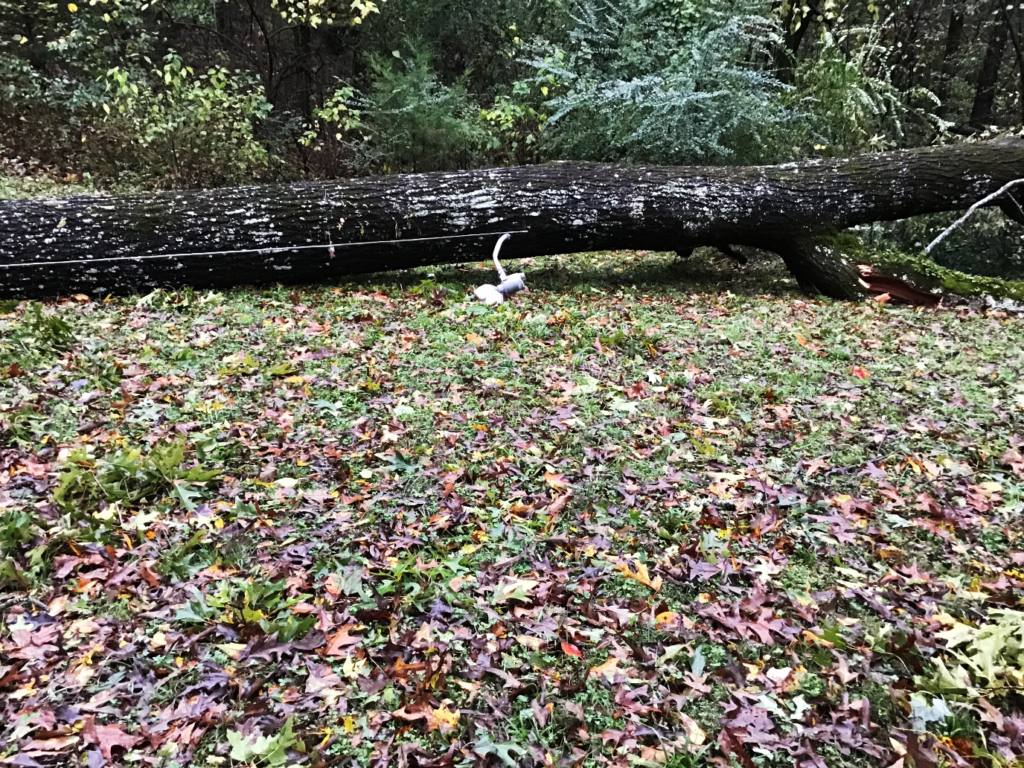Hurricane Ida brought devastating flood and storm damage to Louisiana, but neighboring states, including Georgia, also had their fair share of action from resulting severe weather. While I remind myself that “things could have been worse” we still have some storm damage in North Georgia, and I’ve already had several calls from concerned homeowners wondering what they should do about the storm-damaged trees on their property.
Considering hurricane season is in full swing, Hurricane Ida may not be the last storm to bring trouble to North Georgia. The first factor to consider when dealing with storm-damaged trees is understanding they can be dangerous and are subject to many of the perils associated with tree felling. Oftentimes, one must conduct the removal under difficult conditions, as downed trees are commonly connected with other trees, tossed on buildings, vehicles, or entangled with fencing or electrical wires. Energy stored in compressed limbs and trunks can release suddenly, explosively, and fatally.
Each situation is unique and requires careful consideration. While you may be eager to get your fallen trees removed as quickly as possible, pace yourself and take the time to take pictures and assess the damage, especially if the trees have damaged your home or other structures of value on your property. If damage is extensive, you may need to hire a certified arborist to look at any tree situations that may not be easy to resolve.
Certified arborists have training to equip them to answer complex tree questions. If you cannot locate a certified arborist, be a careful shopper and don’t be afraid to keep looking until you find someone you think can get the job done both correctly and safely. Application of the following five-step cutting plan will help keep the saw operator safe and working effectively.
Five Step Cutting Plan for Storm Damaged Trees
1. Hazards and Work/Drop Zones (electricity)
2. Lean and Load (stored energy)
3. Check Equipment
4. Cut Plan/Escape Plan (three handy cuts, shifting escape routes, and distance release)
5. Implementation of the plan (and then repeat the steps again)
While some tree questions are easier to answer than others, if damage is extensive then it is likely you will still need to hire a tree service. Below are some common questions and answers that can help you decide who and when to call.
“I have a broken tree in my yard! Should I remove it?”

Questions like this sometimes need a definitive answer from a trained arborist or tree service employee. Here are a few guidelines to help you determine when to call for help.
We often see twin trees split. Trees with two equal or almost equal sized branches are usually weak. If half of the tree splits off, the other half is often more at risk to fall. The loss of so many tree branches means that the wind will be pushing on the remaining part of the tree in a whole new way. The tree was accustomed to the wind stress it received before the tree broke. Now the wind pushing on it in a different way can make the tree more susceptible to fall.
“Should I be concerned about trees that have lost many limbs or large limbs?”
If we lose more than 50% of the branches on a hardwood tree or 30% of the branches in a pine, then we probably need to remove the tree to reduce the risk of the rest of the tree falling. If we lose more than 70% of the limbs on one side of the tree, this would also indicate a need to remove the tree.
Let me emphasize – these are general rules. These do not mean that the trees will or will not fall. These rules may help you to determine when to seek more help with your trees. A trained arborist can give you their best estimate of what to do about a tree. They are probably very busy now. Call for an appointment but be patient.
“I have a leaning tree. Is there any root injury?”
If the tree is leaning, then in my opinion, there has been some degree of injury.
If the tree was recently planted and is only leaning a little with minimal root injury, then you can perhaps push it back up and prop it until it recovers (one growing season). Carefully brace the tree without damaging the bark. Secure the tree so it will not fall. If you do brace the tree, brace it loosely so the tree can sway slightly in the breeze. This allows the tree to begin developing strength to resist future winds.
The tree still may never recover and you may be better off replacing it. This is especially true of trees that will be large. Remove any pines that are leaning. If it is a hardwood and roots are broken, remove it. To determine if roots are broken you may need professional help.
If you lost trees as a result of recent storms, fall is an excellent time to add new trees to your landscape. To learn more about planting colorful shade trees, see the UGA publication, “Fast Growing Shade Trees” or contact the Extension office.

Storm-damaged trees can be difficult to remove due to ensnarement with fencing or other obstacles that may preclude a seamless removal.